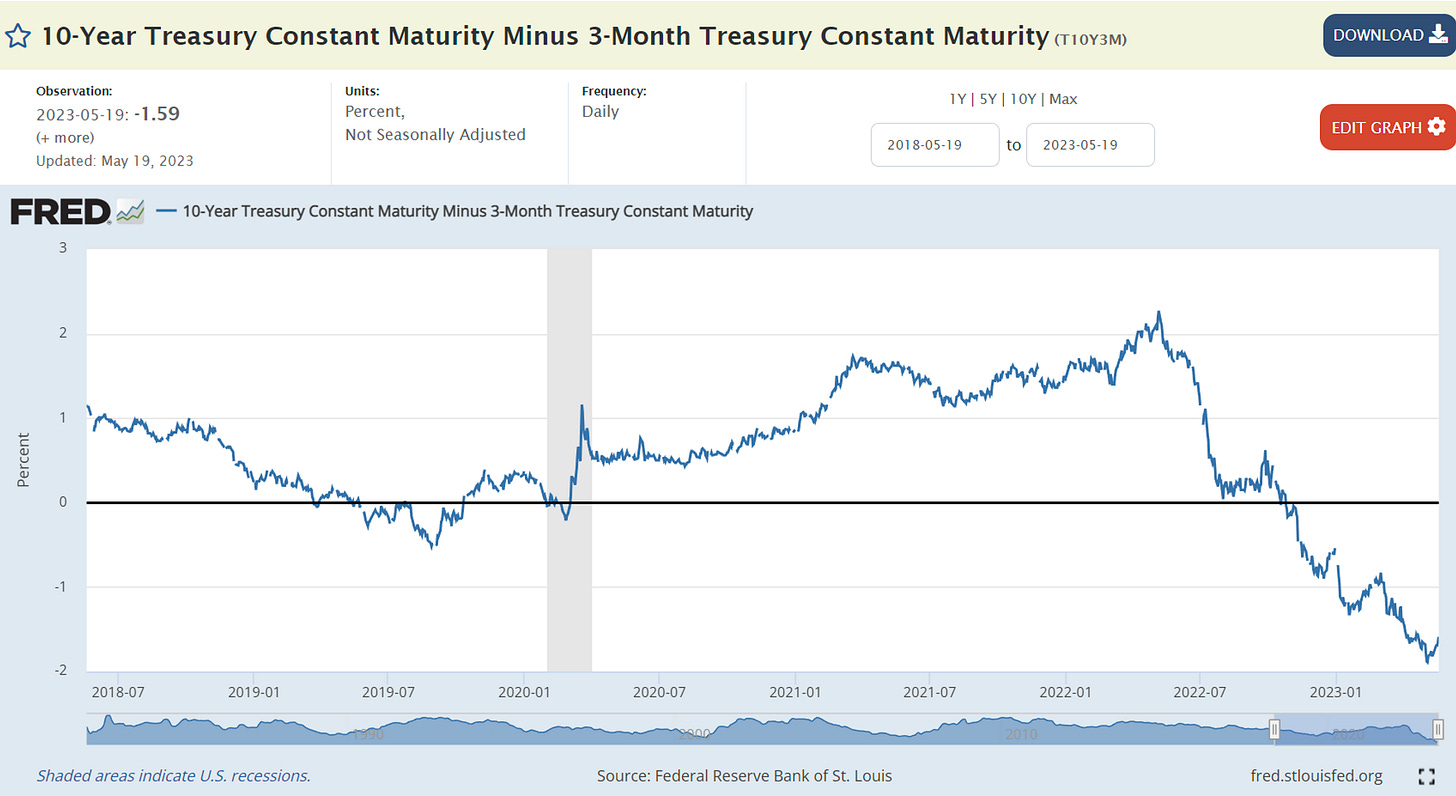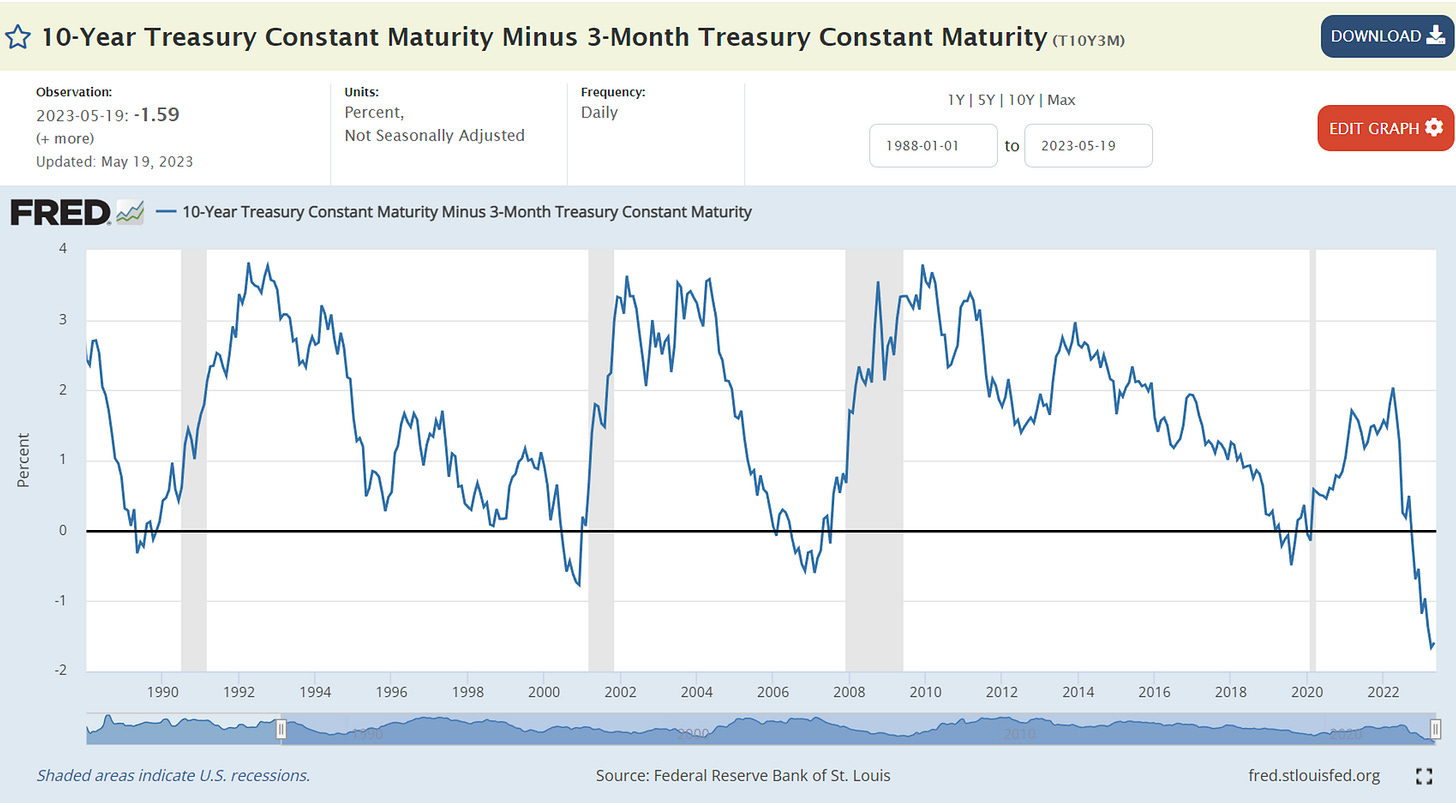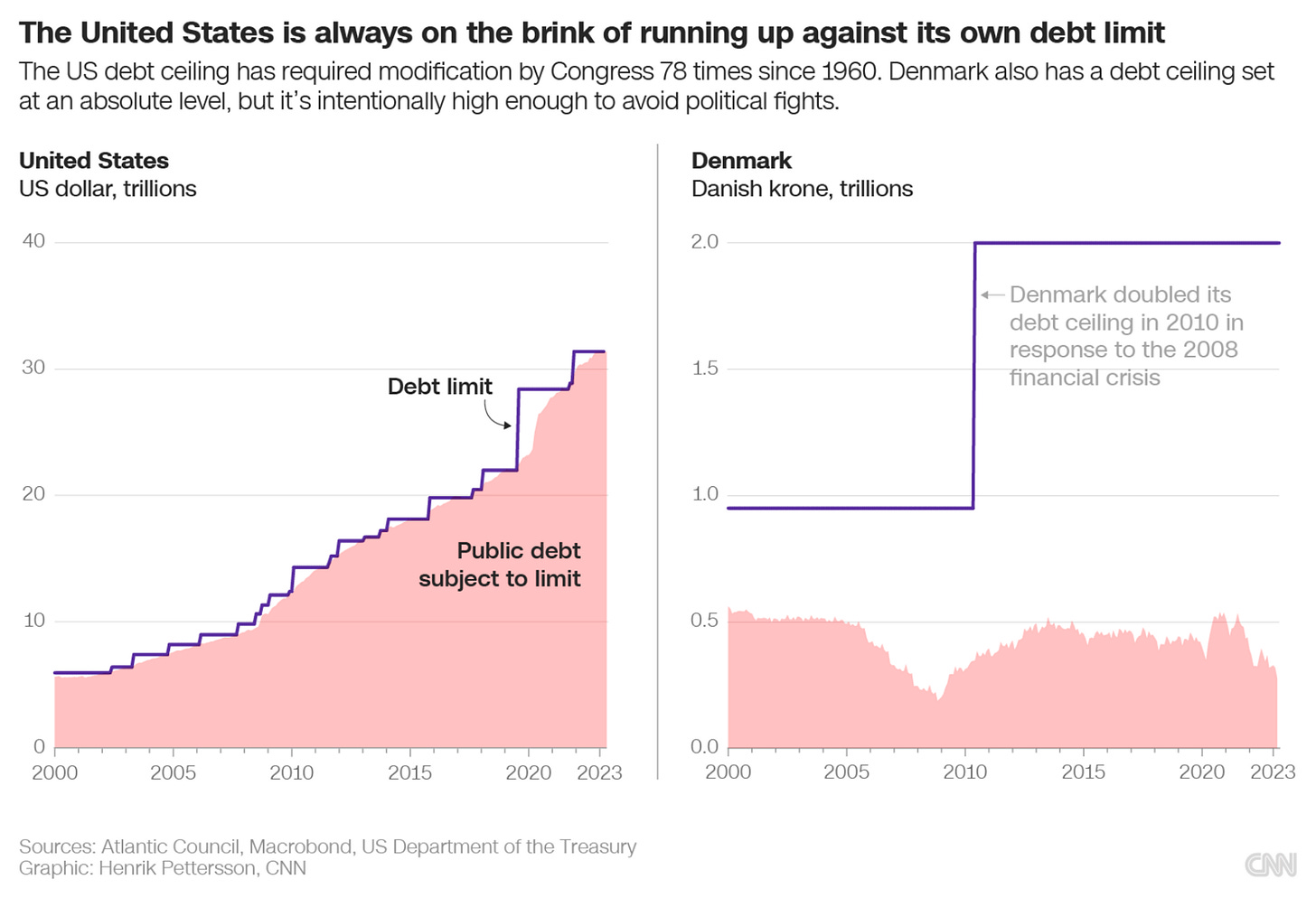Weekly Report: May 21, 2023
Observations
The Debt Ceiling
The Republicans are playing chicken with the debt ceiling again. It’s a travesty how the system works here – namely, that the budget is approved by Congress first, and then as a separate step, Congress has to approve raising the debt ceiling so that the U.S. Treasury can issue new debt to pay for the spending that Congress already approved. This process is almost unique in the world. (Denmark is the other country that works this way, but they don’t practice brinkmanship over there.)
It’s almost impossible to imagine Congress actually taking things over the precipice, but no one is 100% absolutely sure that won’t happen, even though the consequences would be catastrophic if the U.S. were to default on its debt.
- After months of President Biden effectively saying that he wouldn’t negotiate with terrorists who were holding the debt ceiling hostage, it’s telling that he is now negotiating. Clearly, there’s pressure from the Democrats who think the Republicans might let things go too far.
“X-date” is the deadline where the government effectively runs out of money. It fluctuates because it depends on day-to-day tax revenue collected and spending, but “as early as June 1” is the guidance that the Treasury has given.
- The last time things got this down to the wire was in 2011 when the debt ceiling was raised with potentially only a day or two before the government ran out of money. In response, S&P downgraded the U.S.’ credit rating from AAA (the highest) to AA+. In the month leading up to the resolution of the crisis, the stock market fell 17%.
- U.S. Treasury Bonds are regarded as “risk free” assets (or the closest thing you can have to risk free) given the reserve status of the U.S. dollar, the fact that the U.S. economy is the largest in the world, and the ability for the U.S. government to print more money at will. If the U.S. were to default on its debt, it would be entirely self-inflicted.
Interestingly, the market is not reacting like it did in 2011, staying relatively buoyant despite June 1 being a little over a week away. This means the market is expecting things will be resolved before x-date. It has been observed that this means that insurance against a debt default is selling for cheap. This insurance comes in the form of put options on the S&P index (via an S&P index ETF), or alternatively call options on the price of gold or against the VIX (volatility index).
- On May 18, one unit of SPY (an S&P index ETF) was about $415 (about the same as where it was a month ago). A put option on SPY expiring on June 2 at a strike price of $385 (~7% under the ETF’s current value), was selling for $0.40. Should SPY decrease by 17% (the same as in 2011) over the next 2 weeks to $345, the option would return about $40 for a ~100x return. This has not gone unnoticed.
One potential solution to the crisis, where the U.S. Mint mints a $1 trillion coin and deposits it in the Federal Reserve’s Treasury account, has been taken off the table by Treasury Secretary Janet Yellen. As explained by Wikipedia: “The concept of striking a trillion-dollar coin that would generate one trillion dollars in seigniorage, which would be off-budget, or numismatic profit, which would be on-budget, and be transferred to the Treasury, is based on the authority granted by Section 31 U.S.C. § 5112 of the United States Code for the Treasury Department to “mint and issue platinum bullion coins” in any denominations the Secretary of the Treasury may choose. Thus, if the Treasury were to mint one-trillion dollar coins, it could deposit such coins at the Federal Reserve’s Treasury account instead of issuing new debt.”

Further Observations
- Michael Lewis’ book on Sam Bankman-Fried is called Going Infinite and it will be released in October. I’m looking forward to it.
- Sometimes I’m so exhausted that I fall asleep putting my kids to bed and end up waking up a few hours later at around 11pm. After shaking off the wooziness, I then spend the next few hours relatively clear-headed and productive, catching up on emails, work, and household admin, before heading back to bed at around 2am or 3am. I was worried that this messed up schedule might become a bad habit, but it turns out that it’s a natural sleep pattern called biphasic sleep that was common in medieval times: “A couple of hours later, people would begin rousing from this initial slumber. The night-time wakefulness usually lasted from around 23:00 to about 01:00, depending on what time they went to bed. It was not generally caused by noise or other disturbances in the night – and neither was it initiated by any kind of alarm … The period of wakefulness that followed was known as ‘the watch’ – and it was a surprisingly useful window in which to get things done. ‘[The records] describe how people did just about anything and everything after they awakened from their first sleep,’ says Ekirch. … One servant Ekirch came across even brewed a batch of beer for her Westmorland employer one night, between midnight and 02:00.” That makes me feel a bit better.
- A Berkeley student commuted from Los Angeles for an entire academic year. He did this ostensibly to avoid paying rent in the Bay Area (he had free accommodation in LA). From a pure money perspective, the numbers checked out. From a practical perspective, well… His daily commute averaged 4-5 hours each way, and involved a car, plane, and BART ride. He managed to schedule his classes so he only had 3 days a week for most of the year, but during some periods he did have a 5 day week. On some days, he needed to wake up before 4am to catch his flight, and some days his flight back departed at 9pm. But, he managed to make it to every class, every day. The sheer planning and discipline involved, and fortune to not be impacted by delayed or canceled flights, is impressive. He breaks everything down in this great Flyertalk post. There was a 6-month period of my life when I was commuting at least 5 hours a day, every weekday, and I swore I’d never do that again. (Standing in a hot un-air conditioned train for an hour every day is not fun. I once fell asleep while standing up.)
- Here’s how one of his days looked:
“8/11/2022 Thursday LAX-SFO-LAX
AS3342 LAX-SFO E175 $5.60+5000 AS miles
AS3435 SFO-LAX E175 $5.60+5000 AS miles
Leave home 410am
Car Parked 436am
Reach Airport 456am
Flight Departs 600am
Flight Arrives 745am
BART Departs 935am
BART Arrives 1047am
Arrive Class 1100am
[4 hours 20 minutes at class]
Leave Class 320pm
BART Departs 333pm
BART Arrives 448pm
Flight Departs 623pm
Flight Arrives 757pm
Airport Landside 804pm
Reach Parking Lot 822pm
Arrive Home 858pm
That’s when I started questioning myself: 6am flight everyday, is it really worth it? Especially given that I only slept 4.5hrs the night before. But anyways, once I boarded, I slept like a baby until we reached SFO.”
Articles
- What if San Francisco never pulls out of its ‘doom loop’? (Financial Times)
- California Is Losing Population and Building New Houses, So Why Aren’t Home Prices Coming Down? (KQED)
- Students are increasingly refusing to go to school. It’s becoming a mental health crisis. (USA Today)
- TikTok creators use AI to rewrite history (Rest of World)
- What It Takes to See 10,000 Bird Species (Outside)
- Hurricanes of Data: The Tiny Craft Mapping Superstorms at Sea (New York Times)
- ‘We Didn’t Have a Choice’: One Family’ Perilous Escape From Venezuela to NYC (Bloomberg)
While trekking across the Darien Gap—a 66-mile stretch of dense, mountainous jungle between Colombia and Panama—the family was robbed by men carrying guns and machetes. - Rabbit Test (Samantha Mills in Uncanny Magazine)
Worthy winner of the 2023 Nebula Award for Best Short Story.
Charts, Images & Videos
Look at that inverted yield curve:

Now let’s zoom out further…




